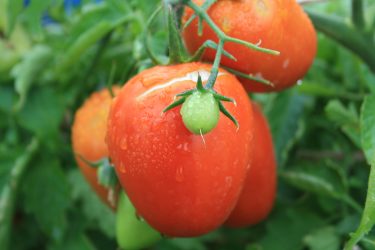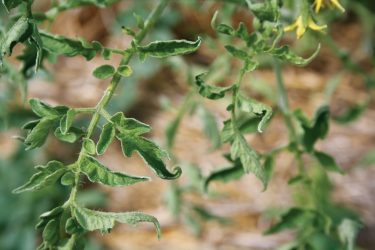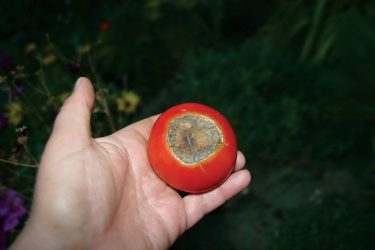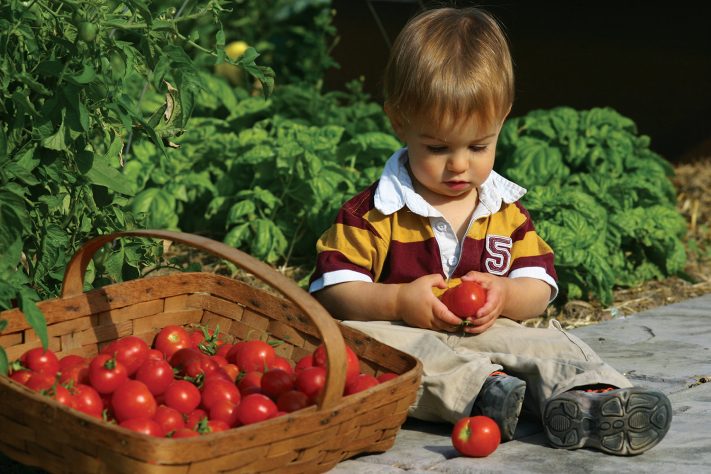Enjoy the Taste of Summer with Minimal Fuss
Text and Photography by Amy Grisak
Tomatoes are treasures of the garden and many of us wait in great anticipation for that first delicious bite. The good news is even in Montana’s short season, practically anyone can grow this prolific and scrumptious fruit.
 The key to memorable tomatoes is choosing the right varieties and creating the best environment to keep them happy. Marcia Bundi, who raises tomatoes that thrive in Montana and taste good at Bundi Gardens in Great Falls, recommends choosing varieties that mature in 73 days or less. Although we typically enjoy over 100 frost free days, cool nights on either end of the growing season slow down tomato development so, unless you have a penchant for fried green tomatoes, choose wisely.
The key to memorable tomatoes is choosing the right varieties and creating the best environment to keep them happy. Marcia Bundi, who raises tomatoes that thrive in Montana and taste good at Bundi Gardens in Great Falls, recommends choosing varieties that mature in 73 days or less. Although we typically enjoy over 100 frost free days, cool nights on either end of the growing season slow down tomato development so, unless you have a penchant for fried green tomatoes, choose wisely.
While heirloom varieties are riding a wave of popularity, Marcia says not to dismiss the hybrid selections. Many of the hybrids are bred specifically for short seasons, and can offer quick maturation, excellent flavor, and disease resistance, yet some people avoid them because they are concerned they are genetically modified.
“Hybrids are not genetically engineered. It’s a naturally occurring process,” says Marcia. Instead of waiting for Mother Nature to create the ideal tomato, breeders continually pair the best qualities by simple cross-selection to create hardy and flavorful specimens. One of the greatest advantages of hybrids is their potential resistance to diseases.
Although Marcia says we don’t have many issues with tomato diseases in Montana, a couple of the most prevalent are Fusarium and Verticillium wilts. She says symptoms such as the leaves turning yellow and curling, along with the entire planting wilting at mid-day are a few of the symptoms of these fungal diseases. In that case, dig up the plant, bag it, and throw it in the trash.
“Don’t compost it,” she says. “And, if you had it, don’t plant solanums (such as tomatoes, peppers, potatoes, and eggplant) in the same area for 5 years.”
One of the best ways to avoid having your plants succumb to the infection is to plant hybrid varieties specially bred to resist it. Marcia says to look for the symbols F and V on the plant description to see if that particular variety is resistant to these one, or both, of the wilts.
 “The other thing I really is see Western Yellow Blight. It’s transmitted by leaf hoppers.” she says. The leaves curl downwards, and are often yellow with purple veining. “As long as the plants are healthy, they’ll be okay,” she says.
“The other thing I really is see Western Yellow Blight. It’s transmitted by leaf hoppers.” she says. The leaves curl downwards, and are often yellow with purple veining. “As long as the plants are healthy, they’ll be okay,” she says.
Probably the most common tomato complaint in Montana is blossom-end rot, (seen to the right) which is a physiological disorder, rather than a disease. This is the issue if the tomato looks normal, but there’s a brown, leathery area on the bottom.
“Blossom end rot is caused by the lack of calcium in the soil and in the plant. It’s also aggravated by uneven soil moisture,” says Marcia.
She saves their eggshells all winter, then stomps on them before adding the crushed eggshells to each hole as they plant their tomatoes.
“Also keep the soil evenly moist. Mulching is going to help,” she says.
Leaf roll is an issue that often occurs during hot, dry weather or when the plant is under stress. The leaves do not change color, yet they curl upwards. Marcia says as long as the plant is growing normally, it will be fine.
 Other problems include the ripe tomatoes cracking and splitting, which is caused by uneven watering, as well as cat-facing. Marcia says cat-facing is due to incomplete pollination that causes deep scars and puckering within the fruit making it inedible.
Other problems include the ripe tomatoes cracking and splitting, which is caused by uneven watering, as well as cat-facing. Marcia says cat-facing is due to incomplete pollination that causes deep scars and puckering within the fruit making it inedible.
When you choose a Montana appropriate variety and provide a healthy growing environment, you can avoid problems and will amaze your friends and family with your bounty of tomatoes.
SIDEBAR: Tomato Favorites
With hundreds of varieties at our fingertips, it’s difficult to choose the right one. Here are a few of Marcia’s favorites:
• Early Cascade – Boasting great flavor in a short season, Early Cascade are prolific plants even in cool seasons.
• Mountain Spring – Not only disease resistant, this variety is not prone to blossom end rot or cracking.
• Stupice – This Czechoslovakia heirloom is one of the earliest to mature. The fruit aren’t large, but the flavor can’t be beat.
• Cherry – Sweet Baby Girl – This variety produces loads of tomatoes without growing exceptionally tall. They’re resistant to both wilts and aren’t prone to cracking.
• Sun Gold – One of the sweetest tomatoes anywhere, Sun Gold is prolific and dependable.
• Large Fruit – Celebrity – Great for sandwiches, Celebrity matures quickly and is disease resistant.
• Big Beef – A nice sized, uniform fruit that matures in 70 days and is resistant to both Fusarium and Verticillium wilts.
• Canning – Wisconsin 55 – Even though it’s not a Roma type of tomato, Wisconsin 55 is excellent for canning, and is renowned for flavor and dependability.
• Opalka – Although they’re a little longer maturing variety, Opalka paste tomatoes have a lot of meat with few seeds and work well making sauce.

